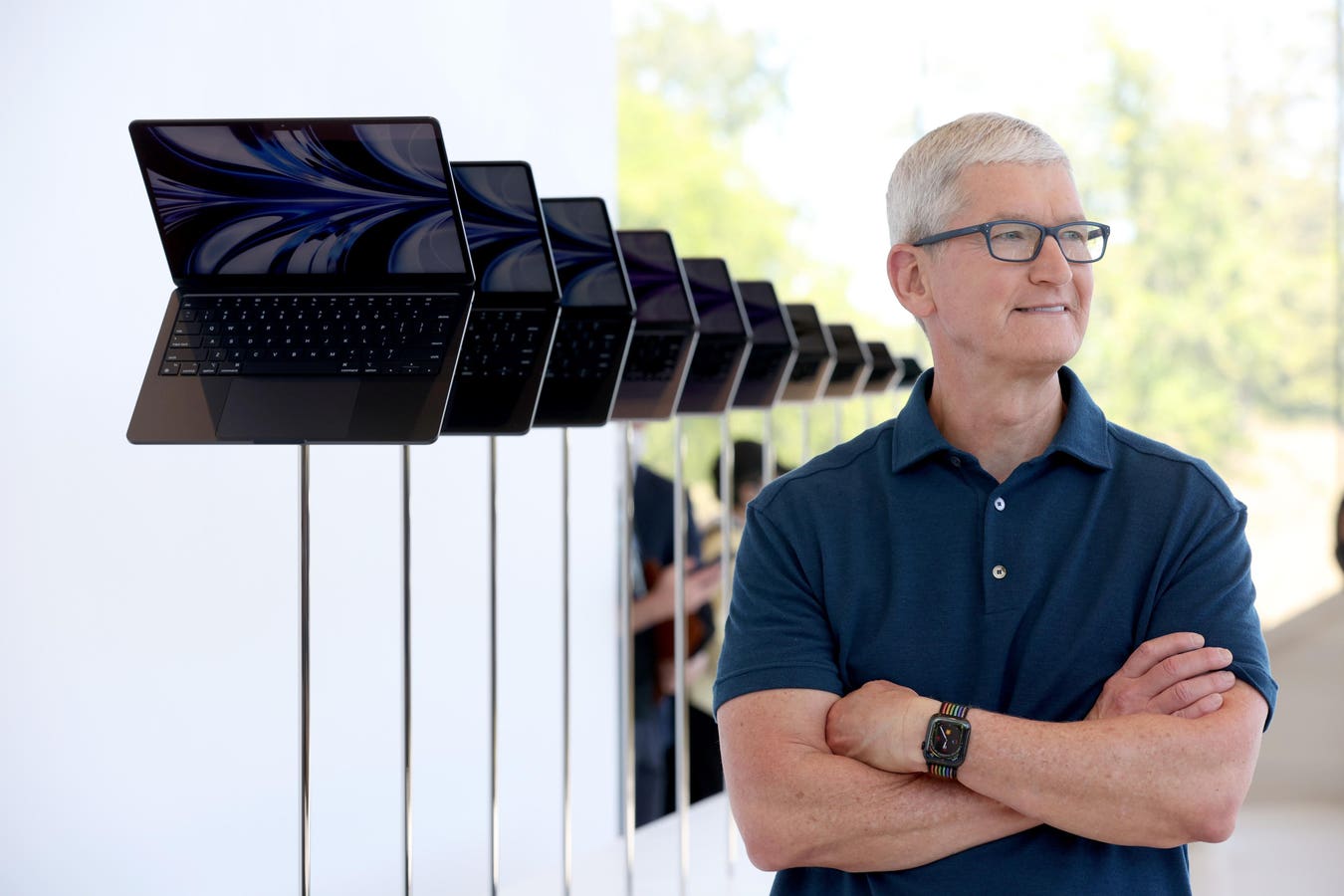Update, Sunday Apr 13, 2025: This article has been updated with details on the iPad Pro and the Apple Silicon M5 chipset.
Apple CEO Tim Cook looks away from a display of redesigned MacBook Air laptops (Photo by Justin … More
How do you sell a laptop like the MacBook Pro to consumers? There’s a clear argument for high-end content creators and developers to look at the Apple SIlicon Pro and Ultra. Yet the consumer-focused MacBook Pro has to deal with the increased challenge of the MacBook Air.
MacBook Pro’s Intel Inside Advantage
When the Mac platform ran on Intel silicon, it was easier to create a gap. The difference in performance from the lower-end to the higher-end chipsets in each generation ensured that the cheaper MacBook Air models with the low-end silicon offered far less performance than the more expensive, higher-priced silicon in the MacBook Pro models. Apple had separation built in, thanks to having Intel inside.
The move to Apple Silicon allowed Tim Cook and his team to offer. Debuting in late 2020, the M1-powered MacBook Air offered benchmarking numbers that saw the processor offering x2 and x3 beneficial increases over the early 2020 Intel model.
Yet the difference between the M1 MacBook Air and M1 MacBook Pro was around fifteen to twenty percent; a value that the average consumer would have a hard time spotting, especially as the M1 MacBook Air offered such a leap over equivalent intel-powered laptops.
MacBook Pro Matched By MacBook Air
In time, Apple would offer Pro and Ultra variants of the chipsets for professional users that would increase the performance, but the rubicon had been passed. The entry-level MacBook was now more than powerful enough for the average consumer.
As the years passed, Apple Silicon improved, and more consumers entered a product buying cycle, Apple faced a problem. If the entry-level machine in 2020 was good enough and steadily improved over four years, how can we upsell consumers from the $999 base to the more expensive and profitable machines?
Apple’s answer is not to use performance as a differentiator. Instead, the differentiator is time.
While the M1 MacBook Air and M1 MacBook Pro launched simultaneously (alongside the Mac Mini), subsequent generations have seen Apple split the schedules by releasing the Pro laptops later than the Air laptop. We’re now in the situation where the M4 MacBook Air has been launched almost a year after the M4 chipset was released. There’s a slight wrinkle in Apple launching the M4 in the “don’t call it a tablet” iPad Pro with the MacBook Pro five months after that and the MacBook Air six months after that.
iPad Pro Pushes MacBook Air Further Away
Update, Sunday Apr 13, 2025: Writing for Bloomberg’s Power On newsletter, Mark Gurman notes not only the upcoming iPad Pro release in the summer. It will come not only with a refresh of iPadOS to bring the UI closer to that of the Mac, but also ship with the newest Apple Silicon M5 chipset. And that weakens the attractiveness of the MacBook Air:
“The revamp is arriving about a year after Apple brought the M4 chip to the iPad Pro, which, in my experience, seriously makes the device fly. The software also is coming around the time new iPad Pros with M5 chips are likely to be ready. For years, users have said that it feels like the hardware capabilities of the iPad are well ahead of its software. That could soon be changing.”
Both of these decisions will have a deleterious effect on the MacBook Air ecosystem. Regarding the hardware, the Air only shipped with the M4 chipset in the first week of March 2025. The reveal of any M5-powered hardware will immediately date the MacBook Air as “last year’s machine” in the eyes of many. The iPad Pro’s move towards looking like a MacBook is another strike against those considering the Air, especially when you add in the Magic Keyboard with its trackpad offering a laptop-esque profile.
MacBook Pro’s Early Arrival
While the base MacBook Pro and MacBook Air specs are similar—although that fifteen percent gap remains—the appeal of Apple has been built on owning the latest models. Be it fashion, fear of missing out, or frustration that there are no more options on sale in the Apple Store, consumers are being pulled towards the “Pro” badged hardware.
The Intel days were easier to understand. The numbers were clear; this laptop is better than that laptop. Today, the levers are more emotional thanks to a higher performance bar. The message of this laptop being better than that laptop is far more subtle but makes for a more straightforward upsell. It’s hard to beat “that’s last year’s model”, even if they are all of the same generation.
Now read the latest MacBook Pro, iPhone and iOS headlines in Forbes’ weekly Apple news digest…








